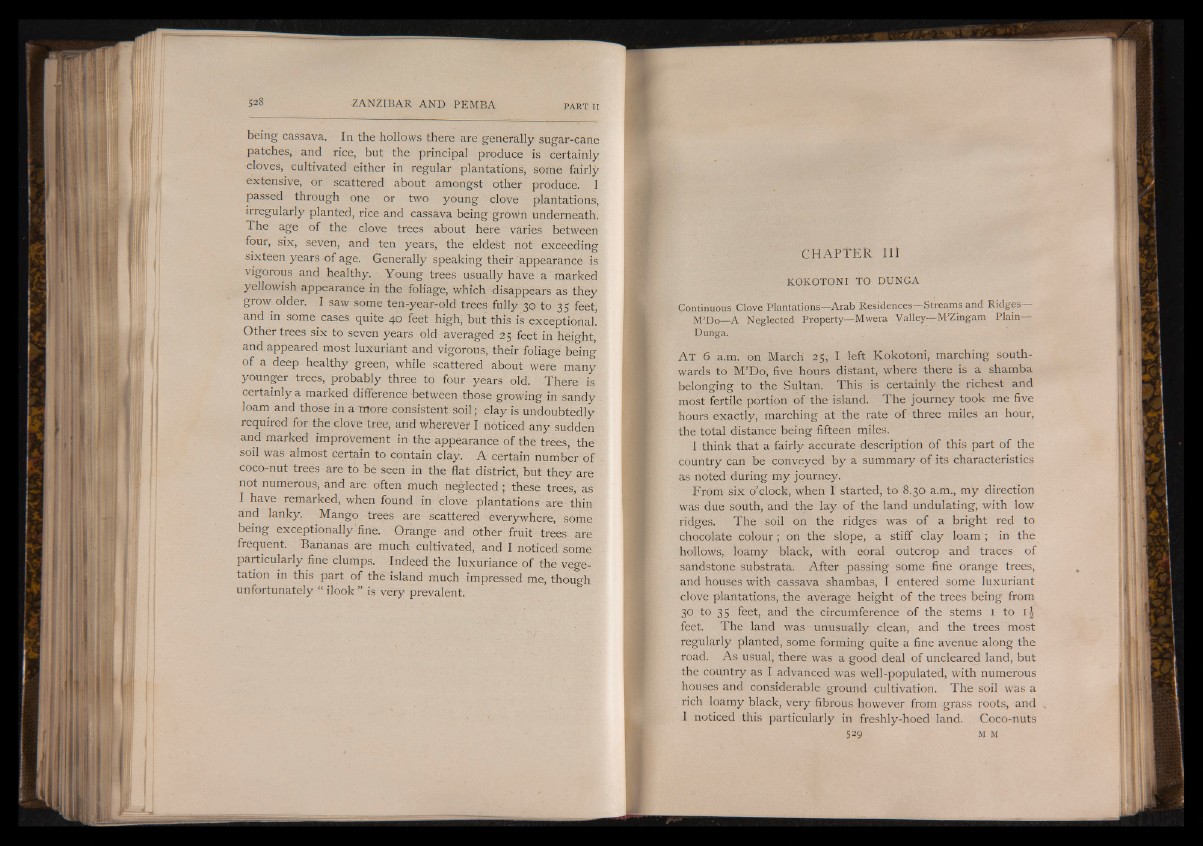
being cassava. In the hollows there are generally sugar-cane
patches, and rice, but the principal produce is certainly
cloves, cultivated either in regular plantations, some fairly
extensive, or scattered about amongst other produce. I
passed through one or two young clove plantations,
irregularly planted, rice and cassava being grown underneath.
The age of the clove trees about here varies between
four, six, seven, and ten years, the eldest not exceeding
sixteen years of age. Generally speaking their appearance is
vigorous and healthy. Young trees usually have a marked
yellowish appearance in the foliage, which disappears as they
grow older. I saw some ten-year-old trees fully 30 to 35 feet,
and in some cases quite 40 feet high, but this is exceptional
Other trees six to seven years old averaged 25 feet in height,
and appeared most luxuriant and vigorous, their foliage being
of a deep healthy green, while scattered about were many
younger trees, probably three to four years old. There is
certainly a marked difference between those growing in sandy
loam and those in a more consistent soil ; clay is undoubtedly
required for the clove tree, and wherever I noticed any sudden
and marked improvement in the appearance of the trees, the
soil was almost certain to contain clay. A certain number of
coco-nut trees are to be seen in the flat district, but they are
not numerous, and are often much neglected ; these trees, as
I have remarked, when found in clove plantations are thin
and lanky. Mango trees are scattered everywhere, some
being exceptionally fine. Orange and other fruit trees are
frequent. Bananas are much cultivated, and I noticed some
particularly fine clumps. Indeed the luxuriance of thé vegetation
in this part of the island much impressed me, though
unfortunately “ ilook ” is very prevalent.
CH A P T ER III
KOKOTONI TO DUNGA
Continuous Clove Plantations— Arab Residences Streams and Ridges
M’Do— A Neglected Property— Mwera Valley— M’Zingam Plain
Dunga.
A t 6 a.m. on March 25, I left Kokotoni, marching southwards
to M’Do, five hours distant, where there is a shamba
belonging to the Sultan. This is certainly the richest and
most fertile portion of the island. The journey took me five
hours exactly, marching at the rate of three miles an hour,
the total distance being fifteen miles.
I think that a fairly accurate description of this part of the
country can be conveyed by a summary of its characteristics
as noted during my journey.
From six o’clock, when I started, to 8.30 a.m., my direction
was due south, and the lay of the land undulating, with low
ridges. The soil on the ridges was of a bright red to
chocolate colour; on the slope, a stiff clay loam ; in the
hollows, loamy black, with coral outcrop and traces of
sandstone substrata. After passing some fine orange trees,
and houses with cassava shambas, I entered some luxuriant
clove plantations, the average height of the trees being from
30 to 35 feet, and the circumference of the stems 1 to i |
feet. The land was unusually clean, and the trees most
regularly planted, some forming quite a fine avenue along the
road. As usual, there was a good deal of uncleared land, but
the country as I advanced was well-populated, with numerous
houses and considerable ground cultivation. The soil was a
rich loamy black, very fibrous however from grass roots, and
I noticed this particularly in freshly-hoed land. Coco-nuts
529 M M